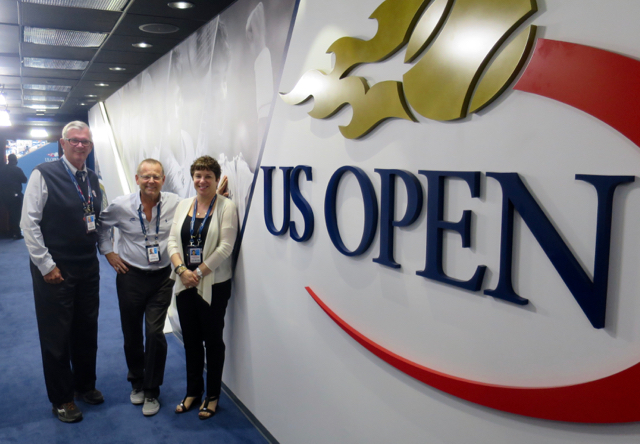Live From the US Open: Roof, Other Changes Re-Energize Broadcasters
Story Highlights
The USTA Billie Jean King National Tennis Center has a whole new feel this year, thanks to the addition of a roof to Arthur Ashe Stadium, an impressive new Grandstand Court, and a revamped campus that offers some serious enhancements in terms of crowd flow, ease of movement, and more. And all the changes are having a positive impact on those involved with TV production.

From left: The USTA’s Steve Gorsuch, Brian Williams, and Patti Kleinman-Fallick in the newly revamped tunnel at Arthur Ashe Stadium
“It has energized everybody because so many people have been here for a lot of years; everyone was familiar with where the courts and other facilities were,” says Steve Gorsuch, director, broadcast operations and production, USTA. “And, among the TV community, there is a lot of wow factor that has given everyone a boost because it has a whole new vibe. We’re pretty excited about that. And, if you saw this place a month ago, you would have said, ‘No way.’”
The biggest change, of course, is the addition of a roof at Arthur Ashe Stadium, which has posed some challenges. There seems to be some issues with respect to increased noise levels in the already noisy stadium, but it also alleviates the stress of waiting out rain delays and the concern of playing the men’s final on a Monday (it also seems to have done such a good job of preventing rain from impacting the Open that the storms, like Tropical Storm Hermine this past weekend, don’t even bother showing up).
“It was the day before the annual US Open Kids Day event prior to the start of the tournament, and I was driving in my car listening to the weather to see if rain would cancel Kids Day when I realized we have the roof and it didn’t matter,” says Gorsuch. “So it’s been fantastic.”
Another enhancement at Arthur Ashe is that Clair Brothers has been brought in to handle entertainment audio.
“They’ve done a very good job,” says Gorsuch. “We went back to having carts on the court for the stage PA. After the tournament, they want to investigate hoisting the speakers to the ceiling. Overall, Clair Brothers have been great to work with, and they have really embraced the event.”
In terms of enhancements, the new Grandstand Court is the biggest completely new addition to the complex.
“Certainly, the camera angles there are terrific, and it’s a great place to be a spectator,” Gorsuch point out. “There are also two video screens that have similar big-screen productions to Arthur Ashe with their own control room, Chase replay review, and entertainment segments; they have their own hard camera and RF camera.”
Technology Changes
The technology side of the facility has also been given a couple of enhancements. More fiber has been laid across the facility to improve audio- and video-signal transport back to the TV compound. This year sees improvements to the interview room as well as to the interview area in the hallway for players going on and off of the court at Arthur Ashe. Both were treated with a new lighting design by Ferri, and the interview room has a completely new production philosophy.

With enhanced lighting and additional cameras, the Interview Room is now essentially a set for a mini TV show.
“The idea for improving the Interview Room began two years ago,” says Gorsuch. “Last year, ESPN jumped in, [seeing] it as something that was cool and could give a lot of traction to another audience for the entire run of the tournament for 13 or 14 hours a day. “
The key enhancement is the use of four cameras: one shooting a wide shot of the player, a second a tight shot of the player, and two robotic cameras capturing reverse shots of the members of the press asking questions.
“You can now see and hear the interaction of the players with the press, and the robotic camera also gives us a chance to cut to another shot,” says Gorsuch. “The control room is located outside of the room behind the player, and three people there control the cameras and switch the audio and video.”
Reverse-angle shots of the media is a rarity in most interview rooms, but Gorsuch thought it would be more compelling than just hearing voices.
“Also, our sound system wasn’t so great; you couldn’t even always hear the question,” he says. “So we amped up the sound system and changed the lighting to make it like a mini TV show.”
From a broadcast perspective, Gorsuch says ESPN is dialed in this year for year 2 of its role as both domestic and host broadcaster. Although Eurosport also has a bigger presence than previously, he notes, Olympics and World Cup years tend to see a smaller presence from international-rights holders.
“We’re down two set locations this year; we have only two on the practice courts, as both Sky and ESPN International do not have sets,” he says. “And, in the South Plaza, we have Eurosport and then the big ESPN stage.”
Not all the changes this year are about technology and improvements to the Billie Jean King National Tennis Center. Patti Kleinman-Fallick, recently named senior director, broadcast operations, USTA, has joined the team.
“I’ve had the pleasure of watching Steve work for the last two or three weeks, and he is a genius,” she says. “He knows every nook and cranny and how to get things done.”
Fallick’s new full-time role with the USTA is to help plan out the broadcast facilities within the Billie Jean King Tennis Center. For example, the decision has been made to make the ESPN Broadcast Center permanent, but work still has to be done with respect to international-rights holders.
“We want to futureproof ourselves,” she says, “and bring in more IP technology and maybe rethink some of the ways we do things.”
